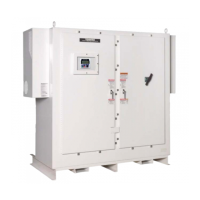HX7+ ASD Installation and Operation Manual 199
Trips/Faults
A Trip is an ASD response to a Fault (though, Fault and Trip are sometimes used interchangeably). A
Trip is a safety feature that disables the ASD system in the event that a subsystem of the ASD is
malfunctioning.
Listed in Table 19 are the possible Faults that may cause a Trip and the possible causes. When a Trip is
incurred the system displays the Fault screen. The Fault screen identifies the active Fault.
Table 19. HX7+ ASD Faults.
Fault Screen Display Possible Causes
ASD Overload • Acceleration time is too short.
• DC Injection current is too high.
• V/f setting needs to be adjusted.
• Motor running during restart.
• ASD or the motor is improperly matched to the application.
Autotune Error • Autotune readings that are significantly inconsistent with the configuration
information.
• A non-3-phase motor is being used.
• Incorrect settings at F400, F413, or F414.
• Using a motor that has a significantly smaller rating than the ASD.
• ASD output cabling is too small, too long, or is being housed in a cable tray with
other cables that are producing an interfering EMF.
• Motor is running during the Autotune function.
Communication Error • Communication malfunction.
• Improper or loose connection.
• Improper system settings.
Control Power Undervoltage • This fault is caused by an undervoltage condition at the 5, 15, or the 24 VDC
supply.
• 3-phase input voltage low.
CPU Fault • CPU malfunction.
DC Bus Undervoltage • 3-phase input voltage low.
• Defective control board.
• Excessive load on the power supply.
• Undervoltage/Ridethrough settings require adjustment.
DC Fuse Open • Internal DC bus fuse is open.
Dynamic Braking Resistor Overcurrent • ASD inability to discharge the bus voltage during regeneration.
• No dynamic braking resistor (DBR) installed.
• Deceleration time is too short.
• Improper DBR setup information.
• Defective IGBT7 (or IGBT7 circuit).
• 3-phase input voltage is above specification.
Note: The event that caused the Trip(s) must be corrected or must decrease to less than the threshold
value required to cause the trip to allow for a Reset to be recognized. In the event of multiple
active trips, the trip displayed will remain until all faults are corrected and all trips are cleared.

